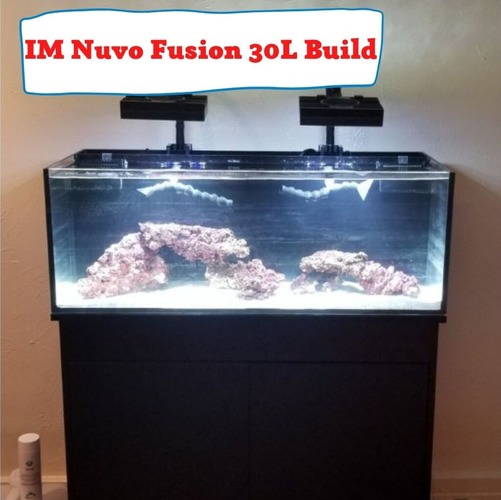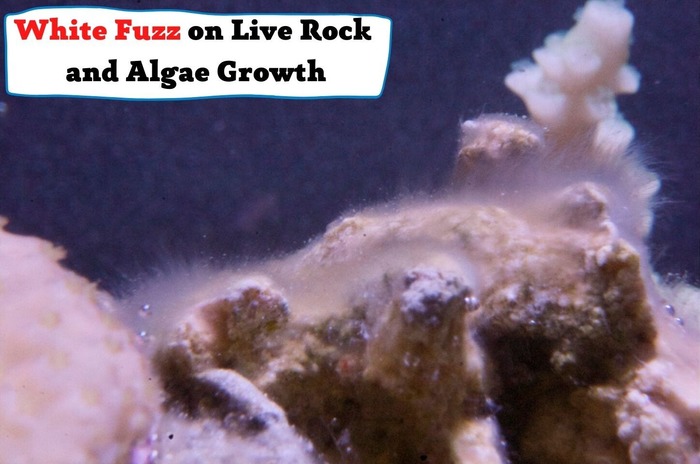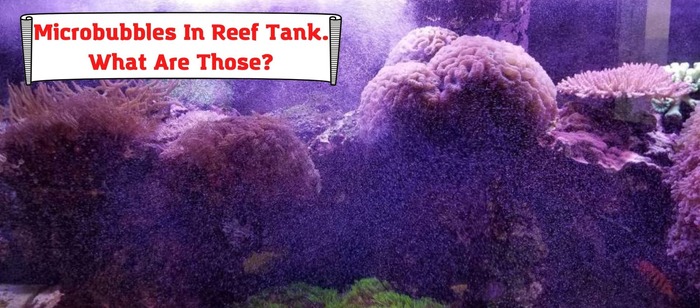
Microbubbles are gas cavities in a liquid made of air, nitrogen, or a gas with a high molecular weight, such as C 3F8 or SF6. Encapsulation with a biocompatible substance like lipid, polymer, or protein stabilizes the microbubbles.
These tiny microbubbles are minuscule, and they are usually pinhead-sized. As a result of their ability to produce microbubbles, a wide range of aquarium equipment is susceptible to microbubble interference. Microbubbles may be avoided or reduced in several ways.
This article presents you detailed information about the microbubbles in a reef tank, including:
- Impact of microbubble on a reef tank
- How to deal with microbubbles?
- How to eliminate them?
- Leading causes of microbubbles in tank
Are these microbubbles harmful?
Everybody despises these microbubbles for the simple reason that they can fool the eye into believing that the fish tank is unclean or dirty, but actually, it is not. There are several reasons behind the cause of microbubbles, but most of the time, the bubbles are caused by your fish tank filter.
Whether or not an under gravel filter is used, air bubbles aid in oxygen and other gas exchanges by moving the tank water vertically towards the surface. They can make a beautiful wall of bubbles in an aquarium that appears extremely relaxing.
The presence of microbubbles is a hotly debated subject among saltwater aquarium hobbyists. Reefs all across the globe have tiny bubbles as a regular occurrence. Microbubbles are harmful to fish and corals when inhaled regularly. These microbubbles, other than being a visual nuisance, are not hazardous.
In saltwater reef tank equipment like power-heads and wave-makers consistently create microbubbles. Filters and protein skimmers trap these microbubbles, generating an exponential increase in the number of microbubbles. The common advantages of this process are:
- Higher PH
- Improved water quality
- Possible removal of organic matter into your mechanical filter
How to deal with microbubbles?
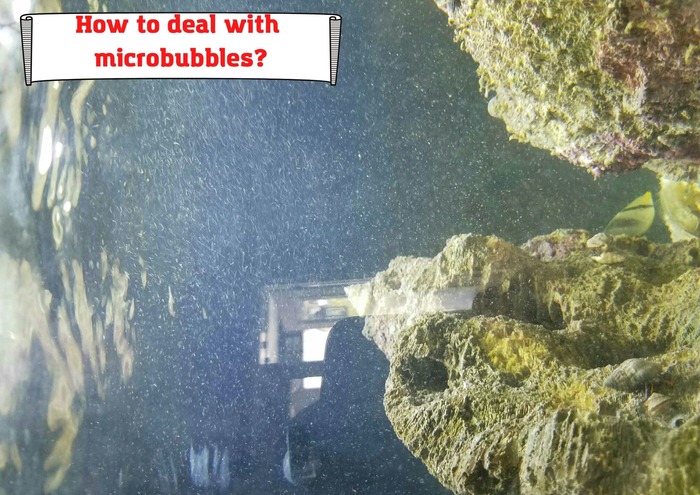
Microbubbles as small air pockets may enter your display tank through the pump and other equipment. These can cause cloudy water in the display tank. Fish hobbyists, especially beginners, feel so overwhelmed with the production of microbubbles in their saltwater reef tanks, and they eagerly try to find the solution of how to keep microbubbles out of their aquarium.
To deal with this cloudy water issue and to keep tiny bubbles out of your saltwater reef tank, it is necessary to find the actual cause of the issue. Usually, a method of “ELIMINATION” is utilized to find the root cause, and then in the next step, by applying particular countermeasures, you can keep these microbubbles out of your fish tank.
In this post, we will discuss different sources of microbubble formation in an aquarium and the ways to prevent your reef tank display from invading.
How to perform Elimination?
It is already described that finding the source of microbubbles is the very first requirement. Only a visual investigation may reveal the cause of excessive microbubble formation. So, visually examine your display tank, lines, sump chambers, and other system equipment.
When air and water combine from the tank to the sump, microbubbles form. It means microbubbles usually form in the drain line, sump, or return line. This may happen when:
- Pumps churn water and air together to empty the tank into the sump
- Equipment like the skimmer mixes air and water to skim
After proper visual examination, it may reveal the source of the microbubbles. For better understanding and deep examination, follow these tips also:
- Don’t forget to check your display tank’s power-heads and any other equipment in or related to it.
- The tiny bubbles may be caused by a section of the power-head above the water level, combining air and water.
- Lower it to resolve the microbubbles if you find that the power-head is over the tank waterline.
- If the microbubbles are only discovered in the return line or lines, investigate the sump visually.
Protein skimmers are the leading cause of microbubbles
A healthy marine system requires foam fractionating or protein skimming in addition to primary biological filtration. Protein skimmers may help to keep the saltwater aquarium clean. They employ tiny bubbles that burst and drop their “films” into a cup. Skimmer’s bubbles only carry the vilest and nastiest muck conceivable.
Here are the top reasons the protein skimmers create microbubbles in saltwater fish tanks:
- When a scummier is a recent addition, microbubbles are common. Plastics used to make protein skimmers contain an electrical charge that might affect the bubbles’ behavior. Bubbles may escape from the unit, or clear skimmate may be produced in excess due to this. Biofilms build on the plastics, and the skimmer will ‘bed in.’
- The aquarium is new or contains a large amount of freshly mixed saltwater. There will be few organic compounds in a fresh aquarium to react with the skimmer bubbles. This is typical and causes bubbles to exit the unit. This corrects itself typically with time.
- The water to air ratio within the unit rises when air passage into the venturi is blocked. Washing bubbles out or the skimmer outlet will boost water throughput in this manner. As salt or calcium deposits accumulate around the skimmer over time, they begin to impede airflow. When this happens, a noticeable difference may be seen when a skimmer is cleaned. Before cleaning the venturi, the flexible tubing and taps should be checked for obstructions.
- They were cleaning protein skimmers with the adjustable water level. The water typically exits in an upward tube. Bacteria or debris buildup inhibits the outflow, causing bubbles to escape. Remove the cap from the outflow pipe’s adjustment rod. Remove or replace the adjustment assembly by hand.
- Surfactants are surface-acting agents that may modify an aquarium’s surface tension. Additives, meals, and medications are the typical surfactants. The size of the bubbles within the skimmer might alter due to variations in surface tension or the bubbles themselves. It is worth finding out what meal, substance, or supplement is causing the issue and finding a replacement if the condition persists for an extended period.
- Microbubbles may appear when the skimmer setup is wrong. The protein skimmer should be placed at the correct water depth, and any pump settings should be adjusted to reflect this. To ensure that the setup is accurate, refer to the product’s instructions.
- The pump must be periodically removed, disassembled, and cleaned to maintain the skimmer working correctly. When dismantling the skimmer to service the pump, make sure to clean all components thoroughly before reassembling the device. The impeller should be free of calcium deposits that might impede its movement.
- High water flow promotes protein skimmer. Bubbles are sucked out of the skimmer if an outlet of a pump blows across its outlet or if the water flow passing through the outlet is vigorous. Reposition the skimmer to protect the output from direct solid flow by sheathing.
Other causes for microbubbles in a saltwater aquarium
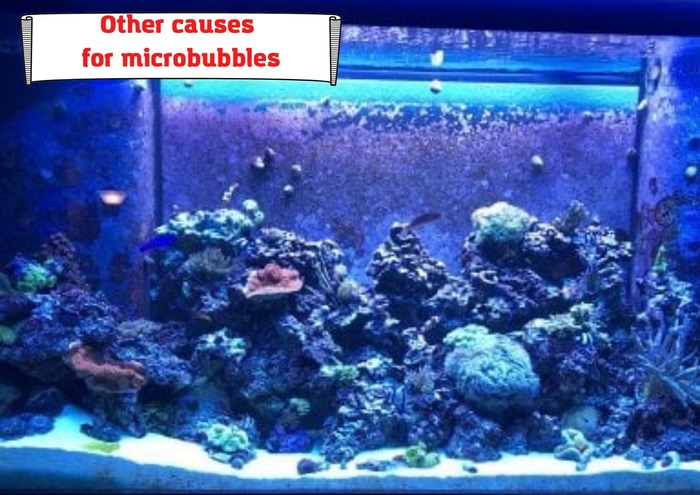
The above section of the article explains how a protein skimmer contributes to the production of microbubbles in a reef tank. Here few other causes of microbubbles production are discussed.
Unsealed canister filters microbubbles
The gasket on all canister tops prevents any leakage. Leaks are caused by the water evaporating and allowing air to enter. It is why this is critical to make sure that your canister cover is placed and installed appropriately. After that, double-check to see that the cap is properly secured.
The dirty tank may also cause microbubbles
When a fish tank is full of unwelcome dirt, it will climb to the top and gather there. Everything on them is now in your tank, including any dust or grime. One of the most prevalent types of microbubbles is the one that doesn’t burst. The primary cause of this is a filthy tank.
The oiliness of your water might be caused by poor quality food, a detergent that got into your tank, or poor quality items. All these factors restrict bubbles from bursting because of the slick surface. The bubbles become stuck in the dirt and dust and can’t be popped.
To restore your tank in working order, begin by changing significant water. A single water change will not remove all debris, dust, and grease from your tank, but regular water changes will. So if you feel that food or other goods you’re consuming are to blame, you may stop utilizing them.
Temperature changes are another factor
Aside from your filter, your tank may include different sorts of tiny bubbles. Microbubbles adhered to your glass or on your décor are a regular occurrence. It’s most common following a water change, and water temperature is to blame.
Warmer water can’t contain as much oxygen as cold water. So if you added colder water to your tank than the water currently in there, you’d get these microbubbles all over your glass.
If you see bubbles after a water change, keep an eye on your fish. These bubbles due to temperature change alone won’t injure your tank or do any harm, but they are a sign that you’re adding water at a temperature that is substantially different from your tank’s temperature. This may be dangerous to your fish and cause them to be spooked due to temperature shock.
How to resolve the issue?

Some of the most modern aquarium equipment may fail due to incredibly few issues, much like many other high-tech items. A sump filter can get clogged with microbubbles. Using filter floss may help alleviate some of the symptoms, but it also has certain disadvantages that other approaches do not.
Water pumps, spray bars, and powerheads are just a few examples of aquarium equipment that may produce microbubbles. Even some aquarium equipment is designed to produce them. A protein skimmer could not filter aquarium water without microbubbles. Because microbubbles accumulate in aquarium plumbing, they tend to merge, forming large bubbles that clog the plumbing, resulting in flooding and other aquarium calamities.
Baffles
The sump filters and overflow boxes of many home aquariums are self-built by enthusiastic amateurs. You don’t need filter floss if you use a do-it-yourself strategy to construct your sump to decrease microbubbles. Baffles are a common component of sumps and overflow boxes. As the bubbles make their way through baffles, they are diverted from sensitive equipment and broken.
Baffles are more resistant to clogging than filter floss because they are significantly larger. Baffles may take up additional space and necessitate incorporating them into the sump design.
Flossing Issues
Filter floss might be too effective at times, and eventually, the fibers will become so clogged with physical debris that they will stop working. As a result, many of the issues the filter floss is designed to avoid might instead be caused by it.
Filter floss may be checked and cleaned regularly, but experts advocate adopting alternative methods to prevent microbubbles from clogging. An aquarium may overflow exactly as drastically as if microbubbles broke the siphon if a filter floss screen used to cover an overflow box becomes clogged.
Fluff the filter
Filter floss is made of synthetic fiber material in coarse sheets. The aquarium industry utilizes it for a wide range of purposes. The material produces an excellent filter for removing dirt from aquariums. So it may be utilized in mechanical filtering equipment. A high surface-volume ratio allows for biological filtration. Even though the material is inexpensive, aquarium enthusiasts have discovered other applications for it, such as preventing microbubbles.
Summing up
The microbubbles can injure no one or anything. It is clear that simply waiting it out is the most efficient strategy to eliminate protein skimmer microbubbles. New skimmers take time to become used to their new home. Try the ways listed above, though, if you want to get rid of them more quickly than by just waiting.
- Pleco Not Eating. Main Reasons Your Pleco Is Starving - February 21, 2022
- Foxface Fish Sting: Any Danger? And What To Do To Relieve Pain? - February 20, 2022
- White Stuff Coming Out Of Snail – Dangerous? Should You Worry About It? - February 19, 2022


